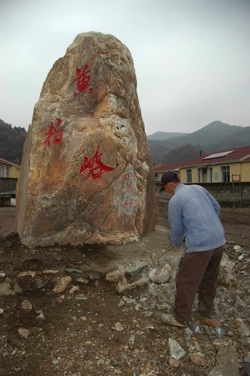
Huangbaiyu The Project
the facts
The project to create what in 2005 has been called both “The World’s First Village” on the Benxi City-hosted website for Huangbaiyu, as well as “Asia’s First Village” by Liaoning Daily was initiated in a conference room at the Beijing Hotel in September 2002.
At the first Joint Board meeting of the China-US Center for Sustainable Development (hereafter, CUCSD), the CUCSD “prioritized the development of a demonstration sustainable village based on cradle-to-cradle design principles as a scalable model for the revitalization of China’s rural communities”. Two and a half years later on May 21, 2005, members of the Joint Board and the Mayor of Benxi celebrated the official launch of the “China-US Center for Sustainable Demonstration Village.”
As a symbolic representation of the weight and fortitude of this work, Dai Xiaolong, the Village Committee Director, as well as lead investor in the project, ordered a 35-ton rock placed at the entrance to the construction site. Unveiled during the celebration, the stone bares the characters for Huangbaiyu (黄柏峪) on the side facing the National Road, and the letters HBY on the side facing the village-in-the-making.
Formed by a Memorandum of Understanding in 1999 signed by China’s Ministry of Science and Technology and the State of Oregon, the stated purpose of the CUCSD is to promote sustainable development design principles through a unique network of public-private partnerships.
The China Secretariat is housed within China’s Administrative Center for Agenda 21, while the Portland,OR-based International Sustainable Development Foundation houses the US Secretariat. The Chairmanship of the China Secretariat is taken up by Deng Nan, Deng Xiaoping’s daughter, and in 1999 the Vice Minister of the Ministry of Science and Technology. Deng is complemented on the US-side by architect and designer William McDonough. Following the principles set forth in the book McDonough wrote with chemist Michael Braungart, Cradle to Cradle: Remaking the Way we Make Things, the CUCSD argues that sustainability should be viewed as an issue of design.
Unlike in China, in the US, the Center would not be a government office, and so would have to raise its own funding as a not-for-profit. The solution was to create a Founder’s Circle, formed of corporations that make multi-year commitments of $50,000 per year to sit on the US Board of Councilors for the Center. As of the groundbreaking at Huangbaiyu, 17 corporations sat on the Board. Of these, Vermeer, BP, Intel, BASF, Wildwood Mahonia, and Ecoworks Foundation have taken an active interest in the “sustainable development demonstration village”.
After the Joint Board decided to take action to design a “sustainable development demonstration community,” what has been called by the US Secretariat as a RFP, or Request for Proposals, was distributed nationally through provincial and city level Ministries of Science and Technology in October, 2002. By January 1, 2003, 10 proposals from 6 different provinces and municipalities came in to the Ministry.
According to CUCSD US Secretariat Managing Director, Wang Miansheng, there were four criteria for site selection: first, that the village be neither a rich, nor poor village so that it could be taken as an approximation of the rural economic conditions in general; second, that it be easily accessible by transportation, as “no foreigners will come if it takes three days to get there”; three, that there be demonstration of local government support; and four, the presence of a local entrepreneur to serve as a key investor in the project. Read more...

Copyright © 2008-2009 Shannon May About me Design Blog Kenya & Life Sundries Blog Contact smay at post dot harvard dot edu
Everything is a work in progress
